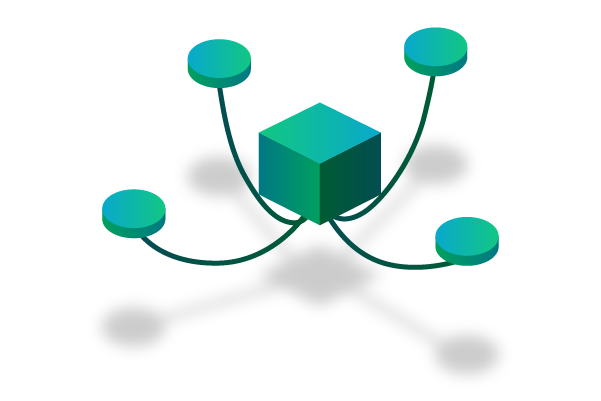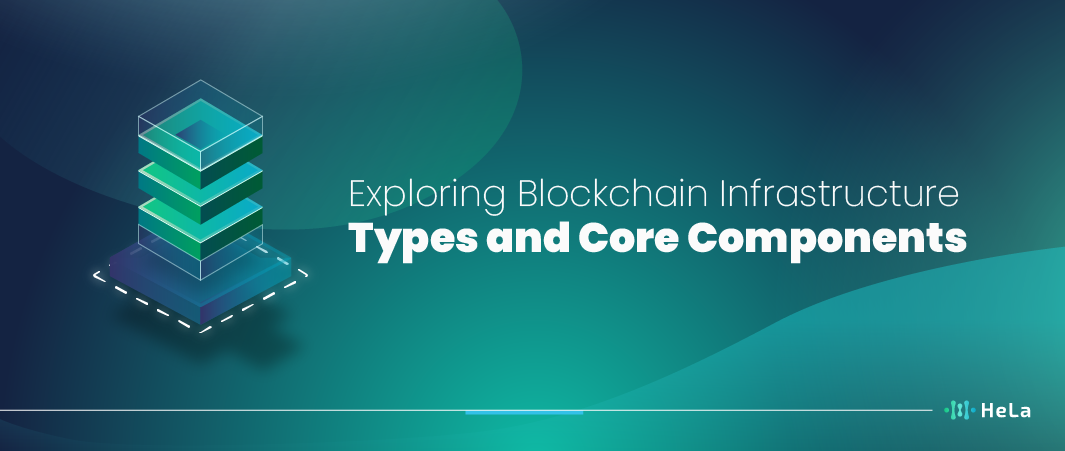The digital revolution has brought forth many transformative technologies, and among the most notable is blockchain. This technology has surpassed its initial application, which was predominantly in the cryptocurrency sector, evolving into an infrastructure that holds promise for various industries.
The term “blockchain” is now common in technology conversations, but what really lies beneath its surface? At its core, blockchain infrastructure provides a decentralized and transparent method of recording and verifying transactions. By understanding its types and core components, one can truly appreciate its potential in transforming the way we operate in the digital realm.
In this article, we will unpack the intricacies of blockchain infrastructures, casting light on its diverse types and the fundamental elements that make it a groundbreaking technology.
What Is Blockchain Infrastructure?

At its most basic definition, blockchain infrastructure refers to the foundational technologies, rules, and mechanisms that underpin and enable the functioning of a blockchain system. It can be likened to the beams and pillars of a building, offering support and structure to the overarching edifice.
Blockchain is not just about blocks of data connected in a chain. It’s an intricate ecosystem comprising nodes (participants), consensus algorithms (how agreement is reached), cryptographic security measures, smart contracts (programmatic contracts that self-execute), and more. Together, these elements interact to provide a transparent, immutable, and decentralized digital ledger.
Also Read: What is CLI in Blockchain? Ultimate Beginners Guide
The beauty of blockchain infrastructure lies in its adaptability. Depending on the needs of a particular application or industry, the infrastructure can be tweaked. This flexibility ensures that whether it’s for a global public system like Bitcoin or a private, company-specific solution, blockchain can be tailored accordingly.
The Evolution of Blockchain
In the beginning, blockchain was mainly known for powering Bitcoin, the original digital currency. But it quickly became evident that its potential extended far beyond just handling financial transactions. Nowadays, blockchain serves as the underlying technology for a variety of applications, ranging from tracking goods in supply chains to revolutionizing voting systems and much more.
What makes blockchain so popular is its inherent trustworthiness. It’s designed in a way that significantly reduces the chances of fraud or data tampering, which makes it an attractive choice for any system that relies on accurate and secure information. This unique capability has led industries all over the world to rethink their processes and incorporate blockchain as a fundamental building block.
In essence, blockchain has evolved from its Bitcoin origins to become the cornerstone of trust in the digital age. Its potential applications continue to grow, as businesses and organizations recognize the transformative power of this technology to ensure data integrity and transparency in various sectors of our modern economy.
Types of Blockchain Infrastructures

Blockchain infrastructures refer to the underlying technology and architecture that enable the functioning of blockchain networks. There are several types of blockchain infrastructures, each with its own characteristics and use cases. Here are some of the key types:
Public Blockchains
Public blockchains are like digital public squares, open to anyone who wants to participate. They work in a decentralized way, which means there’s no central authority in charge. Instead, lots of people around the world run these things called nodes, kind of like computer servers, to keep the blockchain going. To make sure everyone agrees on what’s happening in the blockchain, they use things like Proof of Work or Proof of Stake, which are like ways to make sure nobody cheats. Famous examples of public blockchains are Bitcoin, which is like digital gold, and Ethereum, which does more than just money stuff; it can run smart contracts and other cool stuff.
These public blockchains are like the internet’s trust machines. They let you send money or do other things without needing to trust a bank or a company. Instead, you trust the blockchain itself because it’s open, transparent, and maintained by lots of people. So, it’s like a big, global team effort to keep things honest and secure.
Private Blockchains
Private blockchains are like exclusive clubs for a select group of people or organizations. They’re not open to just anyone; instead, they’re used among folks who already know and trust each other. Think of them as digital tools for things like managing supply chains, where it’s crucial to keep things private among known partners. Unlike public blockchains, where anyone can join, private ones have stricter rules about who’s allowed in, making access control more centralized and less open to the general public. It’s kind of like a private chat group where you invite specific people to the conversation.
These private blockchains are handy for businesses because they let trusted parties collaborate securely. For instance, a group of companies might use a private blockchain to track the movement of goods through a supply chain. Since they all know each other and want to keep their data confidential, a private blockchain suits their needs perfectly. So, think of private blockchains as the cozy, members-only clubs of the blockchain world, where trust and privacy are top priorities..
Consortium Blockchains
Consortium blockchains are semi-decentralized networks where a group of organizations or entities form a consortium to manage the blockchain. These are suitable for industries where multiple organizations need to collaborate while maintaining a degree of control. Hyperledger Fabric is an example.
Permissionless Blockchains
Permissionless blockchains, as seen in public blockchains, allow anyone to join the network, participate in consensus, and perform transactions. The system operates based on predefined protocols and rules that are open and transparent.
Permissioned Blockchains
Permissioned blockchains, on the other hand, require participants to have permission to join and interact with the network. These are common in enterprise settings, where access control and privacy are important. Typically, participants are familiar and reliable entities.
Hybrid Blockchains
Hybrid blockchains are like a blend of public and private blockchains, offering a middle ground where you can have some information out in the open for everyone to see, while keeping other data hidden away. Imagine it as a balancing act between transparency and privacy, and it comes in handy in situations where you need both.
For instance, in a hybrid blockchain, you could share transaction details openly to ensure trust and transparency among participants, while at the same time, you can protect sensitive information, like personal identities or business secrets, by keeping them behind closed doors. It’s like having a secure vault within a glass room – some things are on display, while others remain securely tucked away. This flexibility is especially valuable in various real-world applications, from supply chain management to healthcare records, where different levels of data access are necessary to meet the needs of different parties involved.
Blockchain as a Service (BaaS)
BaaS platforms provide cloud-based blockchain infrastructure and tools to developers and organizations, making it easier to create and manage blockchain applications without the need for extensive technical expertise. Examples include Microsoft Azure Blockchain and IBM Blockchain Platform.
Multi-Chain Ecosystems
Some blockchain infrastructures are designed to support multiple interconnected blockchains within a single ecosystem. This allows for scalability, interoperability, and the ability to cater to different use cases.
Interoperable Blockchains
Interoperable blockchains play a vital role in enabling different blockchain networks to work together smoothly. Think of them as the bridges that connect separate blockchains, making it easy for them to talk to each other and share information. This is incredibly important because it allows different blockchain systems to collaborate and exchange data effortlessly.
Imagine if each blockchain were like a separate island with its own unique language. Interoperable blockchains act as translators, ensuring that these islands can communicate and understand each other’s data. This helps businesses, organizations, and developers harness the power of multiple blockchain platforms, enhancing their ability to work together and create more comprehensive and interconnected solutions. In essence, interoperable blockchains are the key to building a more cohesive and collaborative blockchain ecosystem.
Scalable Blockchains
Scalable blockchain infrastructures focus on improving the throughput and transaction processing capabilities of blockchain networks. Techniques like sharding and layer 2 solutions aim to address scalability challenges.
Energy-Efficient Blockchains
Given concerns about the environmental impact of blockchain technologies, some infrastructures are designed to be more energy-efficient, employing consensus mechanisms other than PoW to reduce energy consumption.
The choice of blockchain infrastructure depends on the specific use case, requirements, and goals of the participants or organizations involved. Each type of infrastructure has its strengths and weaknesses, making it essential to select the most suitable one for a particular application.
Core Components of Blockchain Infrastructure
Blockchain infrastructure is the foundational technology that enables the operation and security of blockchain networks. It encompasses several core components that work together to create a decentralized and tamper-resistant ledger of transactions. These core components include:
Distributed Ledger
At the heart of blockchain infrastructure is a distributed ledger that records all transactions across a network of nodes. This ledger is replicated across all participating nodes, ensuring transparency and immutability. Each block on the ledger contains a set of transactions and a reference to the previous block, forming a chain of blocks.
Consensus Mechanisms
Blockchain networks rely on consensus mechanisms to validate and agree on the state of the ledger. Common consensus algorithms include Proof of Work (PoW), Proof of Stake (PoS), Delegated Proof of Stake (DPoS), and others. These mechanisms ensure that all nodes in the network reach a common agreement on the order and validity of transactions.
Cryptographic Hash Functions
Blockchain networks use cryptographic hash functions to secure data within each block and to link blocks together in a chain. These functions make it extremely difficult for anyone to alter the contents of a block without altering all subsequent blocks, providing immutability.
Smart Contracts
Smart contracts are automated agreements where the terms are encoded directly into the code, enabling self-execution. They enable automation of transactions and agreements, executing actions automatically when predefined conditions are met. Ethereum’s Solidity and other programming languages are used to create smart contracts.
Nodes
Nodes refer to individual devices or computers actively involved in the blockchain network. There are different types of nodes, including full nodes that store the entire blockchain and verify transactions, and lightweight nodes that only verify specific transactions. Nodes help maintain the network’s integrity and security.
Cryptocurrency
Many blockchain networks have their own native cryptocurrencies, such as Bitcoin (BTC) for the Bitcoin network or Ether (ETH) for the Ethereum network. These cryptocurrencies are often used for incentivizing miners or validators and can also serve as a medium of exchange within the blockchain ecosystem.
Network Protocols
Blockchain networks rely on specific network protocols to enable communication between nodes. These protocols define how data is transmitted, how nodes discover each other, and how transactions and blocks are propagated across the network.
Decentralized Governance
Some blockchain networks have mechanisms for decentralized governance, allowing token holders or network participants to propose and vote on changes to the protocol or network rules. This ensures that the blockchain’s evolution is determined collectively by its community.
Privacy and Security Measures
Blockchain infrastructure incorporates various privacy and security measures, including private and public key cryptography, digital signatures, and encryption, to protect the confidentiality and integrity of data and transactions.
Interoperability and Standards
As blockchain technology evolves, efforts are made to establish interoperability standards to facilitate communication and data exchange between different blockchain networks and applications. Interoperability is crucial for the growth of the blockchain ecosystem.
These core components collectively form the foundation of blockchain infrastructure, enabling the creation of secure, transparent, and decentralized systems for a wide range of applications beyond cryptocurrencies, including supply chain management, healthcare, finance, and more.
The Transformative Impact of Blockchain

With its transparent, immutable, and decentralized nature, blockchain infrastructure has the potential to revolutionize industries. Its impact can be seen in:
Supply Chain
Blockchain technology, known for its transparency, immutability, and decentralized structure, holds the promise of transforming various industries. One notable area where it’s already making waves is in supply chains. By leveraging blockchain, companies can ensure that products can be tracked and traced all the way from their origin to the end consumer. This transparency not only helps in reducing fraud but also enhances the overall efficiency and trustworthiness of supply chain operations.
Also Read: Blockchain Layers: A Beginners Comprehensive Guide
Healthcare
In the healthcare sector, blockchain offers the potential to establish a unified and secure patient data system. This innovation can significantly improve the quality of patient care and boost medical research. By securely storing patient records on the blockchain, healthcare providers can ensure data integrity and accessibility, leading to more accurate diagnoses and treatment plans. Moreover, researchers can access a wealth of anonymized data for studies, fostering advancements in medical science while maintaining patient privacy and security.
Finance
In the realm of finance, blockchain technology is streamlining transactions, reducing fraud, and introducing innovative financial instruments such as cryptocurrencies. By utilizing blockchain, financial transactions can be processed more efficiently, cutting down on the time and costs associated with traditional banking systems. The immutability of blockchain also helps combat fraud, making it more challenging for bad actors to manipulate financial records. Additionally, the emergence of cryptocurrencies has provided individuals with new avenues for investment and decentralized financial services, fostering greater financial inclusion and innovation in the industry.
Real Estate
In the real estate sector, blockchain is simplifying property transactions and significantly lowering the risk of fraud. Through blockchain technology, property records and transactions can be securely and transparently recorded. This simplifies the often complex and paperwork-heavy processes involved in buying and selling real estate. It also reduces the chances of fraudulent activities, such as double-selling or tampering with property records, by creating an immutable ledger that ensures the integrity of property ownership data. This innovation is poised to bring greater efficiency and trust to the real estate industry.
The possibilities are endless, and as the technology matures, its applications will only grow.
Conclusion
Blockchain infrastructure, despite its technical complexity, stands out for its potential to be a game-changer in the digital era. From its humble beginnings with Bitcoin to its current widespread application across industries, it underscores the significance of decentralized, transparent, and secure systems in our interconnected world.
Understanding the types and core components of blockchain is the first step in recognizing its potential. As industries continue to adapt and integrate this technology, it becomes essential for professionals and enthusiasts alike to grasp its fundamentals.
The future is decentralized, and blockchain infrastructure is paving the way for this new frontier. With continuous research and development, the technology promises to redefine how we interact, transact, and trust in the digital age. Embracing and understanding blockchain today means being prepared for the world of tomorrow.
Disclaimer: The information provided by HeLa Labs in this article is intended for general informational purposes and does not reflect the company’s opinion. It is not intended as investment advice or recommendations. Readers are strongly advised to conduct their own thorough research and consult with a qualified financial advisor before making any financial decisions.

I am Carina Caringal, a technical writer specializing in blockchain engineering concepts, decentralized systems, crypto infrastructure, and Web3 technologies. My work focuses on analyzing and translating complex technical mechanisms into precise, structured, and insightful content for both developers and non-technical readers who want a deeper understanding of the decentralized ecosystem.
My background in blockchain and cryptocurrency is rooted in years of independent research, continuous learning, and hands-on exploration across multiple protocols and network architectures. I study the underlying mechanics of distributed ledger technology, from consensus algorithms and smart contract logic to network scalability, security models, cryptographic principles, and interoperability frameworks. This technical foundation shapes the way I approach every article, ensuring accuracy, depth, and relevance.
- Carina Caringalhttps://helalabs.com/blog/author/carina-caringal/
- Carina Caringalhttps://helalabs.com/blog/author/carina-caringal/
- Carina Caringalhttps://helalabs.com/blog/author/carina-caringal/
- Carina Caringalhttps://helalabs.com/blog/author/carina-caringal/

